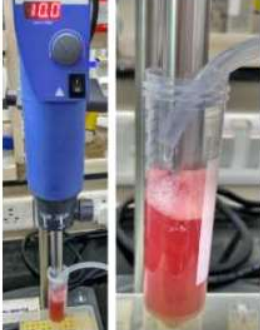The invention is a low-cost, paper-based biosensor for detecting salivary alpha amylase using smart core-shell nanoparticles. It shows a visible blue-to-red color change upon enzyme contact, enabling stress or saliva detection. The test is antibody-free, rapid, mobile-app compatible, and suitable for both healthcare and forensic use.
Figure (1) Development of Core shell nanoparticles using high shear homogenizer; (2) Transmission electron microscopy image the chitosan core (2A) and the coreshell nanoparticles (2B), clumping of the nanoparticles as seen in the presence of amylase (2C) (Scale bar= 100 nm); (3) Cryo FEGSEM images of the nanoparticles after exposure to alpha amylase showing coalescence of the particles explaining the larger size of the particles
Salivary alpha amylase (sAA) is a biomarker for stress and has relevance in both healthcare and forensic investigations. However, current enzyme detection systems are expensive, involve complex fabrication steps, and rely on costly reagents like antibodies, which restrict their point-of-care applicability.
- Smart Core-Shell Nanoparticles: It utilizes biopolymer-based core-shell nanoparticles with a red dye-loaded chitosan core and a blue starch-iodine shell that degrades upon exposure to salivary amylase.
- Visual Readout & Mobile App Integration: Enzyme activity triggers a visible blue-to-red color change, quantifiable via RGB values using a mobile phone app.
- Antibody-Free & Affordable: It eliminates the need for antibodies or metallic labels, reducing cost.
- Paper-Based Disposable Format: This technology incorporates the nanoparticles into Whatman filter paper, enabling a simple, equipment-free test.
- Stable and Biocompatible: It offers enhanced stability and shelf life through biocompatible materials.
Core-shell nanoparticles were synthesized and successfully immobilized on paper and swab-based devices. The system was validated using simulated saliva, skin swabs, and cloth samples to mimic real-life forensic scenarios. A clear color change from blue to red was observed upon exposure to salivary alpha amylase, with RGB analysis confirming the transition. The detection cut-off was established between 140 to 160 IU/mL. A mobile application was developed to analyze the RGB values and classify the results, indicating whether the user is “Stressed” or “Not Stressed” based on enzyme levels.
The technology has been demonstrated through hypothesis testing in both lab settings.
4
This low-cost, rapid, and user-friendly biosensor enables widespread access to stress diagnostics and forensic detection of saliva. It is particularly useful in low-resource settings and can contribute significantly to mental health diagnostics and criminal investigations.
- Healthcare and Medical Devices: Enables non-invasive, rapid stress detection using saliva samples at the point of care
- Forensics and Crime Scene Investigation: Helps detect latent saliva on skin or surfaces, aiding in evidence collection
- Emergency and Defense Diagnostics: Useful for stress monitoring in field personnel during high-pressure operations
- Wearable/Biodegradable Sensors: Can be integrated into disposable formats for continuous or on-demand monitoring
- Mobile Health and Home Diagnostics: Facilitates easy, at-home testing using a smartphone app for result interpretation
Geography of IP
Type of IP
201921009096
423566



